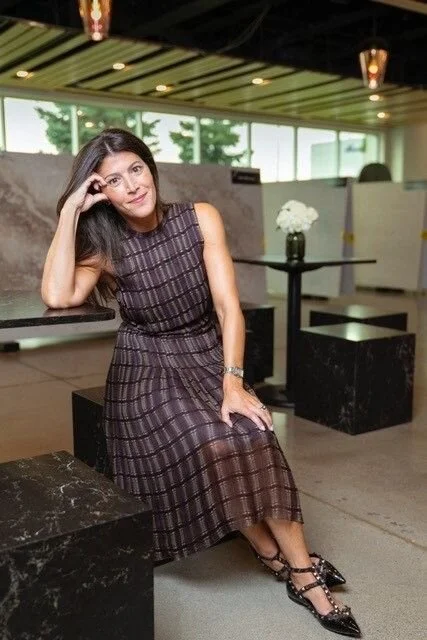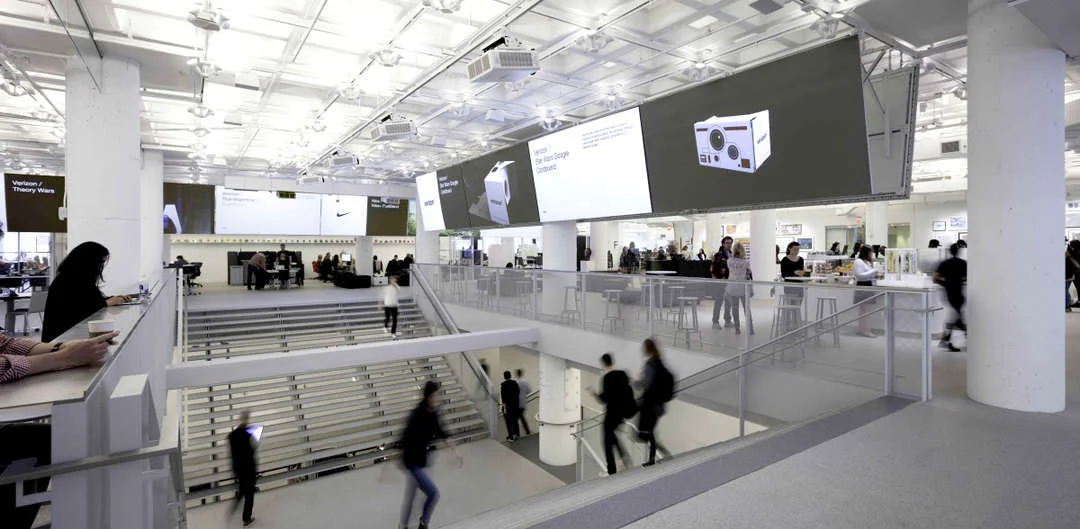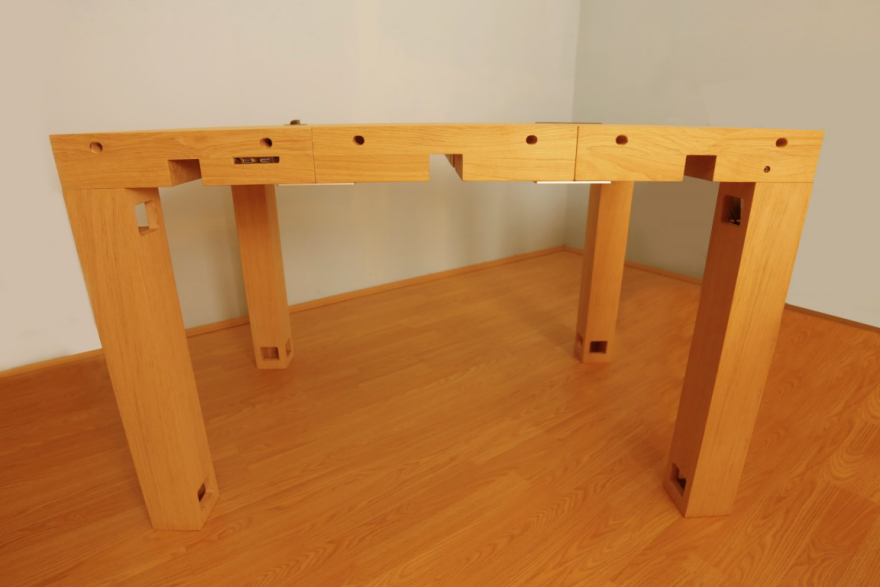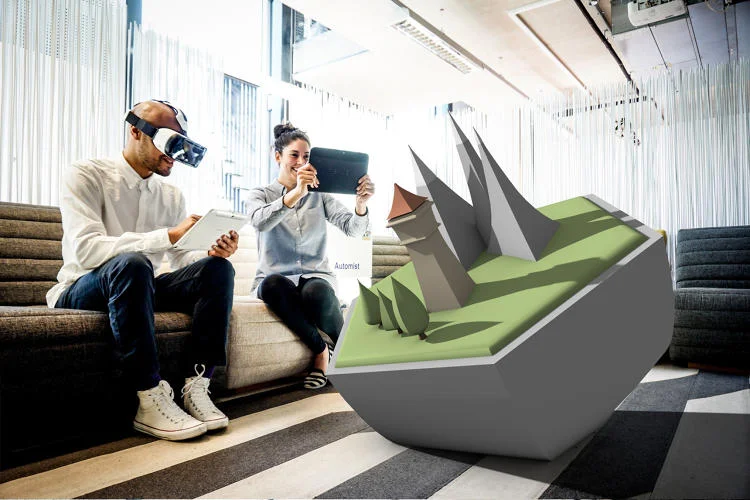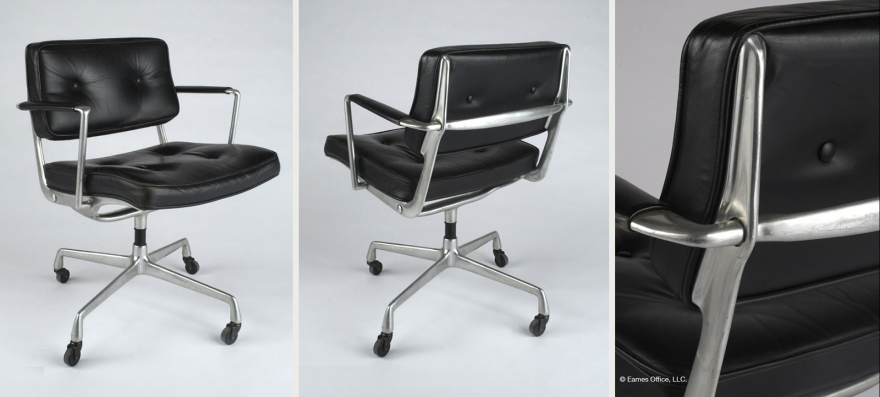“Workplace,” the latest documentary from director Gary Hustwit, had a run of screenings at the Architecture & Design Film Festival last week. As the most recent entry in Hustwit’s series of design-focused films — preceded by the popular “Helvetica” as well as “Objectified” and “Urbanized” — it presents another opportunity to watch the director and his team dive into a discipline in a way that is both highly esoteric and highly accessible. Premiered at the Venice Biennale earlier this year, the film will be released by the director online later this fall.
Yea or Nay? Deskbloks, "The World's First Modular Desk"
This is a project whose concept is meritorious enough to look at, but problematic enough that we should talk about it. Deskbloks are a system of technology-embedded oak squares which end users are meant to assemble together into a desk.
This Stunning House Was Made Entirely From The Remains Of A Demolished Office Building
Ah, the Netherlands. A land of wealth and good taste where even a demolished office building can get a second life as a sunny bungalow worthy of an eight-page spread in a shelter magazine. In the Dutch city of Utrecht, architect Rolf Bruddink has built himself a gorgeous new home in a 19th-century coach house—using only material salvaged from the destroyed office next door.
Bruddink, who runs Studio Rolf (and is responsible for this fantastic M.C. Escher-esque renovation) bought the land with the coach house and the office building in 2011. The original coach house was built in 1895 in the back of an aristocrat's home on the historic Maliebaan avenue in Utrecht. In 1955, a wooden one-story outbuilding was built, but was abandoned and not in use by the time Bruddink acquired the land. While demolishing it, the architect had the idea to use the recovered material as the sole construction material for the coach house he planned to refurbish for himself and his girlfriend.
The Brave New World Of Google's Industrial Design
Google is, first and foremost, a software company—beyond search, there's Chrome, Gmail, Google Drive, Maps, its AI projects, and many more. But this week, the company staged a "Made By Google" product announcement that marked a serious new foray into hardware, introducing a phone, VR headset, smart home device, Wi-Fi router, and new versions of its TV streaming device—all coming to stores in November. Software is still what ties it all together, though: each device makes use of Google's Assistant, its AI-powered voice-control software that harnesses the power of the company's machine learning to do whatever you ask.
Tom Dixon launches first range of Office Furniture
British designer Tom Dixon has launched his first collection of office furniture, which includes a minimalist lamp and a workstation based on archetypical Victorian school desks.
Dixon designed the range to accommodate the ever-blurring boundaries between the workplace and the home.
Pieces are intended to provide function and flexibility while being attractive enough to be on show in living spaces.
How Midcentury Modern Became The Pumpkin Spice Latte Of Interior Design
"It’s like camouflage." That’s how one design gallerist, Patrick Parrish, explained the enduring popularity of midcentury modern design to the New York Times this week, in a piece entitled "Why Won’t Midcentury Design Die?"
It’s a question critics have been asking, in various ways, for decades. It helps that midcentury design encompasses a remarkably wide and ill-defined period, encompassing many decades and many distinct schools and movements. Meanwhile, midcentury design also plays into our collective fixation on tidy, clean spaces. A lot of it was designed to be mass-produced—and indeed, plenty of knock-offs have sprung up online. It is humane and inclusive, an inoffensive design camouflage that can easily be picked up online or in countless chain stores around the country. It's reigned in pop culture, from Mad Men to Keeping Up with the Kardashians. "I'm reading a book about Le Courvoisier, which is an architect," Kris Jenner recently said in one clip. "It's so weird and boring, but I'm obsessed."
Interview with Herman Miller's Mark Catchlove on Modern Office Environments
As part of Herman Miller's presentation at its National Design Center of Milan an engaging conference with mark catchlove, director of knowledge and insight, was arranged where he delivered an insightful speech covering current issues in office spaces ranging from the importance of collaboration and how we deal with spaces for impromptu meetings; to how we respond to contemporary privacy expectations and what the human fundamental needs in office environments are.
VR May Be A Legitimate Design Tool Sooner Than You Think
Tiltbrush is the ultimate sketching app. You can decorate a snowman, wireframe a tiny house, or draw jaw-dropping landscapes, filled with dragons made of flame paint that stretch the length of your living room. But there’s a catch: while you can technically export the images to 3D software to play with further, there’s no seamless, Adobe-style workflow for VR content. And so no one seriously designs in VR.
Pair Chair
With over 8,000 color combinations, Pair Chair, designed by Benjamin Hubert for Republic of Fritz Hansen, is a versatile object for interior designers and architects.
Launched at The Republic of Fritz Hansen showroom as part of London Design Festival, the Pair Chair embraces the Mid-Century design language that Fritz Hansen pioneered, utilizing a pressed plywood shell with a strong sense of fluid geometry. The traditional material of the seat shell is paired with an injection moulded polycarbonate backrest, creating an interesting tension between old and new and modernizing the Fritz Hansen material palette. The backrest is moulded with 10% transparency, which elevates the plastic material by giving it a glass-like quality.
Zaha Hadid remixes midcentury design in a final furniture collection
Midcentury mania is in full swing, and even the late, great Zaha Hadid couldn’t stay away. With her untimely death in March, Hadid left behind a slew of works in progress, including her final furniture collection for long-time friend and gallerist David Gill. Designed by Hadid in close collaboration with Patrik Schumacher, current principal of Zaha Hadid Architects, UltraStellar was Inspired by wooden pieces from the ‘50s and ‘60s.
Though the materials—walnut and leather—feel familiar and vintage, the forms are predictably Zaha, which is to say, out of this world. Fluidity and a sense of weightlessness pervade the series, which comprises a four-piece coffee table that encloses a hole, a large dining table with a glass eye in the middle, and arched chairs. UltraStellar is on view at David Gill Gallery in London through October 2016.
The radical roots of modern interior design
A new exhibition at the Museum of Modern Art (MoMA), How Should We Live: Propositions for the Modern Interior, which opens this weekend, argues that the social shifts kicked off changes in our domestic spaces began in the late ‘20s and ‘30s, when a cadre of radial designers and architects, often women who haven’t fully gotten their due, reshaped space in a way that still influences modern life. Ideas of efficiency, free-flowing space, modern materials, and better design unshackling us from household drudgery—still part of the dialogue today—were pioneered generations ago.
The 25 Most Innovative Health Care Designs Of The Year
Minding your health has never been easier, from a wearable that tracks sun exposure to waiting rooms that are fun to hang out in. The honorees for the health category of the 2016 Innovation by Design Awards vary dramatically from one another in form and function. Yet they all emphasize a key thing: the user, whether that's a young football star who needs protection against concussions or a genetic scientist who can now run DNA experiments from her desktop. These 25 designs put people first.
The Future Of Dynamic Office And Industrial Design
“The buildings may be obsolete, but if the bones are good you can open the roof, create windows, and it can become a dynamic building.” So said Chuck Carefoot, VP of construction with Ryan Companies US, Inc., during the “Speed of Change: Designing Office and Industrial Building for the Future” session at NAIOP’s Commercial Real Estate Conference 2016, attended by a record 1,400 commercial real estate professionals. The panel, moderated by Joe Bass, SVP of development for Hillwood, looked at the prospective use of office and industrial buildings.
As always, location is preeminent. “We are seeing reuse of existing buildings in great locations. In many cases, these are obsolete buildings previously classified as Class C in Class A locations,” said panelist Jay Todisco, EVP of Ware Malcomb.
Furniture made from recycled newspaper has brick-like strength, marble finish
Sometimes designers make furniture out of paper and leave nothing to the imagination—just look at these lumpy lamps and stools. But such is not the case with a new furniture series from Netherlands-based designer Woojai Lee, who’s managed to transform paper into a polished, brick-like material.
Aptly named "Paperbricks," the project has so far yielded two coffee tables and a bench. These pieces were created from recycled newspaper that was, as Designboom details, first turned into pulps and then mixed with glue and shaped into "bricks." Upon closer inspection, the pieces actually reveal a marble-like finish. Recycling paper isn't difficult, but Lee’s exploration shows how the ubiquitous material can be reused in a way that avoids downgrading the quality of the fibers.
MIT And Google Give The Cubicle A Radical, Shape-Shifting Redesign
Once heralded as an ingenious design strategy for saving money and fostering collaboration, the open-plan office has fallen from grace. It's increasingly viewed by employees as a stressful, noisy nuisance, but with real estate prices soaring, it's not an easy trend for many companies to reverse. That's why some of the best solutions have been small-scale interventions that reconfigure existing open-plan spaces to fit employees' needs in the moment.
But ask Skylar Tibbits to design a reconfigurable space for your open office and you're going to get a whole different animal. That's what happened after Drew Wenzel, a civil and environmental engineer who is part of the campus development team at Google, met Tibbits and started collaborating with him earlier this year.
WEST ELM OPENS MAKERS STUDIO IN BROOKLYN
West Elm has been showing their commitment to artisans and designers in many ways lately with their local program and their Minted x West Elm collaboration. Now, they’ve taken it to the next level with the West Elm Makers Studio, a state-of the-art creative workspace located at Industry City in Sunset Park, Brooklyn, New York.
The space is pretty expansive at 11,600 sq. ft. and will house more than a dozen artists, designers and craftsmen who design and develop West Elm products. If you’ve ever wanted to see or know how/where your products come from, then this is the perfect opportunity because they’re holding guided tours during second annual Industry City open studio event THIS Saturday, April 18 from 11 AM to 6 PM. I hope we’ll be able to stop by and check it out soon—It’s like a dream creative workspace!
The Chair in Charles Eames' Office
Visitors to the Vitra Schaudepot, the newest building on the Vitra Campus, can now see Charles Eames’ personal office, just as it was when he passed away in 1978.
The Little-Known Eames Intermediate Chair
This year the Vitra Design Museum opened a new building, the Schaudepot, on their campus. Inside is a recreation of Charles Eames' personal office, "just as it was when he passed away in 1978." (What is Ray, chopped liver? Sadly there's no mention of her office.)
Inside we can see that Charles worked on a George Nelson desk. The chair, however, was of he and Ray's design: The Eames Intermediate Chair from 1968.
Three design trends defining the way we work
From the smart phone in our pockets and the fitness tracker on our wrist to the coffee machine in our kitchen, we now live in a world of connected devices. A Goldman Sachs report suggests that the internet of things has the potential to connect 28 billion “things” to the internet by 2020, ranging from bracelets to cars. Embedded with sensors, these objects are designed with the ability to collect, store and analyse data and can be controlled remotely.
A New Approach to New Products
At FirstBuild’s headquarters there’s a sign reminding all who do work at the appliance-development factory that “A prototype is worth a thousand meetings.”
It’s an operating tenet for FirstBuild and other companies trying to change the way new products are created by liberating the process from the confines of slow-moving, bureaucratic research-and-development departments.
Using a concept known as open innovation, companies are learning how to quickly harvest loads of ideas for new products from business partners, suppliers, consumers and their own employees outside of their R&D staffs. At the same time, they’re shrinking the time needed to create prototypes to months from years.



